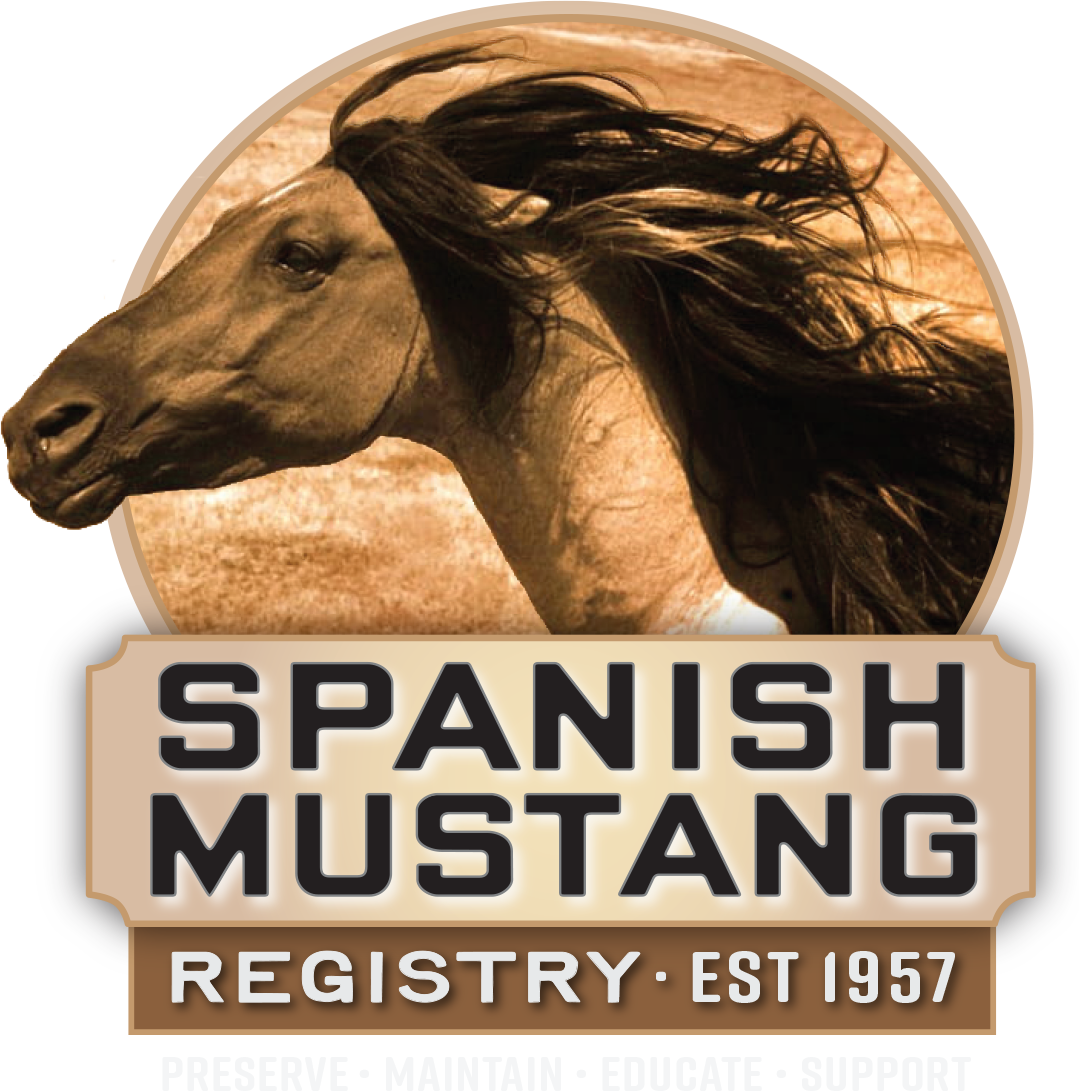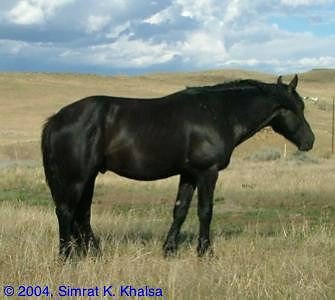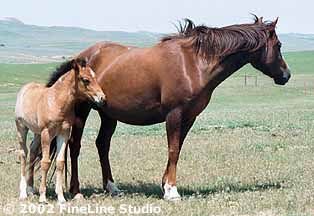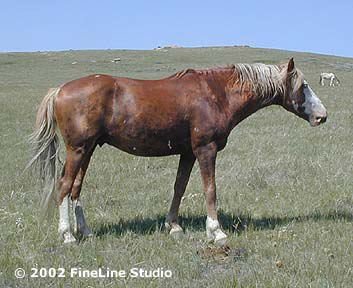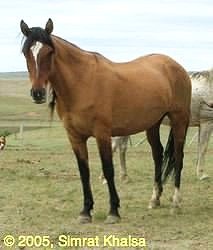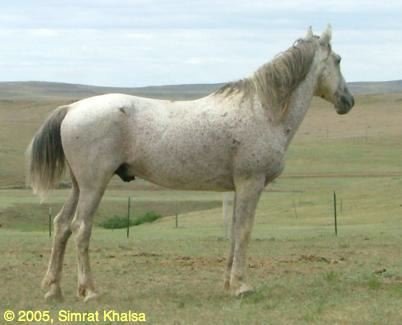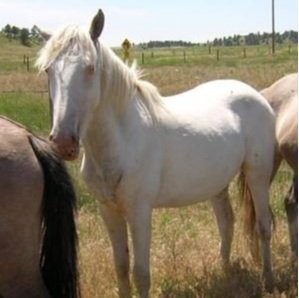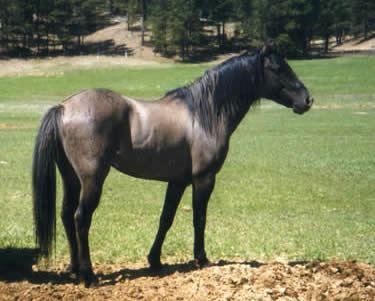A Breed of Many Colors
Pictures and information courtesy of Simrat Khalsa, Cayuse Ranch, Many Ponies, and Caballos de Destino.
Note: While terminology may differ by country and region, these are the terms currently used by color geneticists. The science of the equine color genome is constantly evolving, so terms and classifications are not set in stone.
Below is a sampling of some of the varied colors and patterns that occur in the Spanish Mustang.
Base/Standard Colors
Modifiers
-
Only affects black hairs on the body lightening them to bay. Does not effect chestnut (red) at all.
-
Includes dorsal stripe and usually "primitive" markings of leg and shoulder barring, darker face mask, etc. on all variations.Grulla–Black with the dun modifier becomes grulla or grullo.Red Dun–Chestnut with the dun modifier becomes red dun.Bay Dun–Bay with the dun modifier becomes bay dun.
-
Only affects red or chestnut hair, leaving black apparently unchanged and the points on buckskins. Black with the creme modifier does not affect the look of the horse, but a “smokey black” will have one creme gene and can pass that on to produce palomino or buckskin foals. Chestnut with the creme modifier becomes palomino. Bay with the creme modifier becomes buckskin. A true buckskin, with no other modifiers, will not have a dorsal stripe.
-
Grey is a modifier. This is because grey an ongoing process of depigmentation of the colored hairs. Grey slowly removes the pigment from the base color, other modifiers (such as Mealy and Sooty) and dilution genes (such as Cream & Dun) that make up the original color of the horse. Grey has the unique ability to mask everything including any Pinto or Appaloosa patterns.
Patterns
-
Roan is a color pattern caused by white hairs mixing with colored hairs. There are no “Roan” hairs on a Roan horse. Any color can be Roan, but the contrast is more easily seen on dark colors and the physical effect may be “masked” by other genes such as Grey or any Pinto or Appaloosa patterns or combination of patterns. One trait found with the Roaning patterns is for the points on the front legs to come to a sharp point above the knee. This can occur with all Classic Roan variations.
-
A horse with the Frame pattern will look like it has a "frame" of color surrounding the white. Horses with this pattern will have dark legs. In contrast the head of a Frame horse usually has a white marking that may range in size from a very small star to a large blaze that may be an odd shape. These small markings, such as a star or strip are usually thought to be just a basic white marking but are in fact an indication of Frame, especially if the horse has one or two blue eyes.
-
Sabino (Sah-BEE-no) is a white spotting pattern that is usually included with Frame and Splash and given the generic name, Overo. This is because it displays pattern characteristics which can be very similar to either of these patterns. One Sabino characteristic is a white marking on the face which can vary from a few white hairs to a large blaze. Another very common characteristic of Sabino is white on the lower lip and/or chin, ranging from small to large. Some very minimal Sabinos may not have this characteristic white spotting but will have other traits of the pattern. Leg white that ranges from a coronet to a high stocking is also common. There really is no rule as to how many legs are white, but generally at least one will have some white on it. Patches on the knees, that are not connected to any other white, are also a trait that can occur with Sabino.Another common characteristic of Sabino is roaning, this is the most minimal expression of Sabino. This can vary from a small amount of roaning concentrated in any one area of the horse to roaning that covers the entire body. It’s also common for roaning to be found on the head and legs, especially if a white marking is present. This roaning will vary in extent from very minimal to very extreme.At it’s most maximum expression Sabino will cause the horse to be totally white, if any color remains it’s usually as roan or speckled on areas such as the ears, tail base, chest and flanks, these areas may not have colored hair, it may just be the colored skin showing through the white hair.
-
Splashed White is another white pattern that can look similar to Frame and Sabino, because of this it's also usually grouped in with those patterns and given the generic term, Overo.Facial markings on Splashed Whites are commonly bottom heavy and may involve just a snip. Larger markings tend to give the horse an “apron” marking. Leg white tends to be crisp and may be more blunt than with other patterns. As with Sabino there really is no rule as to how many legs will be white but in general at least one will be and it's common for the hind legs to have marking while the front legs do not. The leg markings will range from small to large, a coronet to a high stocking. Belly spots are common, even on horses that don’t have very large facial markings or high leg markings. If the body has white it occurs in a very unique pattern. It’s as if the horse was dipped in paint, starting with the legs and nose. The horse is white from the bottom up, arranged in a horizontal pattern. When the body is marked like this it's not uncommon for the head to be extensively and sometimes completely white with just the ears having color. The line between the white and color is very sharp and crisp. Blue eyes are very common and thought of as the rule with this pattern.
-
Dr. Sponenberg uses the term “Leopard Complex” because his theory is that all of the different patterns are related to one another, although many of the patterns are quite different in physical appearance. Like the Pinto patterns, two or more Leopard Complex patterns can occur in the same horse. It is in no way linked to the colored parts of the body of the horse. The pattern is just superimposed over the body of the horse and what color the horse is has nothing to do with what pattern it is or what pattern it's foals will be. Sparse manes and tails sometimes go along with the various patterns associated with the Leopard Complex, this is sometimes called “rat-tailed.” There are also many horses of these patterns that have full manes and tails, so the association between the Leopard Complex and the sparse manes and tails is uncertain. Just like the Pinto patterns, the Leopard Complex patterns also range from maximum to minimum expression.Mottled—This is the most minimal expression of the Leopard Complex patterns. These characteristics are found on horses with no body spots as well as on horses that have lots of spots or pattern.Mottled Skin—this is small dots on the skin of the mouth, eyelids, genitalia and anus. On pigmented skin these dots are pink or white, on pink skin, these dots are pigmented. White Sclera - the sclera of the eye is very frequently white on horses with the Leopard Complex. Some old-timers call this “walleyed.”Striped Hooves—horses with the Leopard Complex frequently have striped hooves, regardless of if the color of the leg.
Specials
-
-
Medicine Hat is the name applied to horses exhibiting a unique and rare pattern of color. Being mostly white in body, Medicine Hats have color on their ears and top of the head which resembles a bonnet. Color on the chest is termed a shield. A line of color appears down the back from withers to tail head, need not be in a solid line. Other areas of color vary, but may show around one or both eyes and in the flanks. Often one or both eyes are partially or totally blue, especially when the area around the eye is lacking pigmentation. There are exceptions, some have dark eyes surrounded by white skin. Medicine Hats may be of any base color, often roaning of the base color is present as well. Medicine Hats are described by their base color such as bay Medicine Hat, black roan Medicine Hat, chestnut Medicine Hat, etc.
-
A name given to horses of a similar pattern which exhibit less color, usually having just a bonnet and very little, if any, other colored areas. Legend has the Medicine Hat Horse appearing in Native American culture, being used as a Ceremonial Horse, Buffalo Runner, and a War Horse. Some of the Plains Tribes which considered the Medicine Hat to be supernatural protection against harm were the Sioux, Cheyenne, Blackfoot, Comanche and Kiowa Tribes. Paintings of special symbols were used on the mostly white Medicine Hats to add strength to the horse and depict special events, such as battles and captured ponies, in the life of his rider.
-
Brindle markings can show up on any color of a horse. The darker the horse, the more striking they can be, with the white hairs drizzled vertically down the horse’s body. Brindle coats are rare. Most brindle horses carry no gene for brindle. Rather it is a combination of genetics called ‘chimera’ that causes it - when the cells of two non-identical twins fuse. Another form of brindle is genetic.
